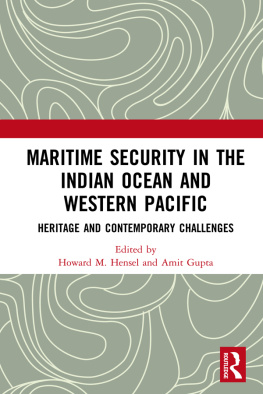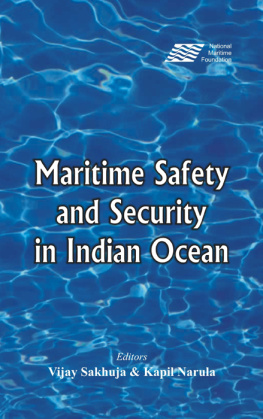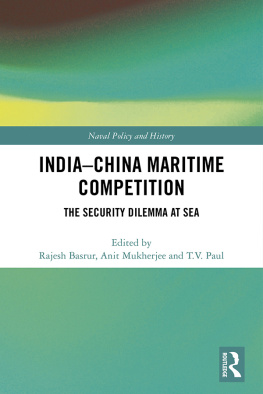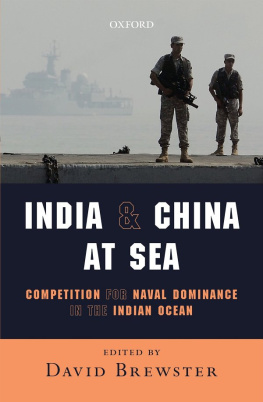
Indias Maritime Strategy
The first book by a former Indian naval intelligence officer on Sino-India relations, Indias Maritime Strategy provides a unique insight into the Indian Navy, tracing its post-independence growth and discussing its transformation and future in the twenty-first century.
In the context of the rise of Chinas maritime power in the Indian Ocean, this book provides a nuanced view of the extent and scope of Indias maritime reach and the effect of this on Sino-Indian competition. Challenging the view that by developing a favourable environment alone, India could seek to maintain its balance of power with China, it is argued that despite durable bilateral security ties with most regional states, Indias maritime aspirations to be the primary net security provider for the region are unsustainable in the long term.
This book presents a comprehensive coverage of Indias bilateral maritime security engagements with all the Indian Ocean regional states, as well as the United States, France, the United Kingdom, and Russia. As such, it will be useful to students and scholars of Indian and South Asian politics, international relations, and maritime security.
Shishir Upadhyaya is a former Indian naval officer with a background in operations and intelligence. He is an alumnus of the Defence Services Staff College and obtained his PhD in International and Security Studies from the University of Wollongong, Australia.
Politics in Asia Series
Regional environmental politics in Northeast Asia
Conflict and Cooperation
JeongWon Bourdais Park
The International Politics of the Asia-Pacific
Fourth and Revised Edition
Michael Yahuda
The Korean Paradox
Domestic Political Divide and Foreign Policy in South Korea
Edited by Marco Milani, Antonio Fiori and Matteo Dian
The Ever-Changing Sino-Japanese Rivalry
Philip Streich
Risk Management Strategies of Japanese Companies in China
Political Crisis and Multinational Firms
Kristin Vekasi
The Political Economy of Press Freedom
The Paradox of Taiwan versus China
Jaw-Nian Huang
Inequality and Democratic Politics in East Asia
Edited by Chong-Min Park and Eric M. Uslaner
Indias Maritime Strategy
Balancing Regional Ambitions and China
Shishir Upadhyaya
For the full list of titles in the series, visit: https://www.routledge.com/Politics-in-Asia/book-series/PIA
First published 2020
by Routledge
2 Park Square, Milton Park, Abingdon, Oxon OX14 4RN
and by Routledge
52 Vanderbilt Avenue, New York, NY 10017
Routledge is an imprint of the Taylor & Francis Group, an informa business
2020 Shishir Upadhyaya
The right of Shishir Upadhyaya to be identified as author of this work has been asserted by him in accordance with sections 77 and 78 of the Copyright, Designs and Patents Act 1988.
All rights reserved. No part of this book may be reprinted or reproduced or utilised in any form or by any electronic, mechanical, or other means, now known or hereafter invented, including photocopying and recording, or in any information storage or retrieval system, without permission in writing from the publishers.
Trademark notice: Product or corporate names may be trademarks or registered trademarks, and are used only for identification and explanation without intent to infringe.
British Library Cataloguing-in-Publication Data
A catalogue record for this book is available from the British Library
Library of Congress Cataloging-in-Publication Data
A catalog record has been requested for this book
ISBN: 978-0-367-02814-5 (hbk)
ISBN: 978-0-429-39765-3 (ebk)
Typeset in Times New Roman
by codeMantra
Indias maritime environment in the Indian Ocean region is a complex interplay of several factors, predominantly, the unique geography of the region with various choke points, an abundance of strategically important natural resources, and the proliferation of non-traditional security threats that require urgent attention. These issues are compounded by a lack of adequate maritime capacity amongst many of the regional states to manage their maritime affairs. Against this backdrop, the rise of Chinese influence in the region has been the most significant geopolitical development of the twenty-first century. As an emergent superpower, China is critically dependent upon its maritime trade and economic interests spread across the Indian Ocean region. Consequently, the past few years have seen a steady expansion of Chinese maritime power in the Indian Ocean with further enhancements expected in the near future under Chinas ambitious maritime silk road (MSR) programme. This has far-reaching implications upon the overall India-China balance of power.
The blurring of traditional and non-traditional lines
This book seeks to assess Indias maritime strategy to critically examine its efficacy and sustainability in the context of the prevailing maritime security environment in the Indian Ocean. This examination includes an assessment of Indias capacity to be the net security provider for the region and addresses the question whether the extant maritime strategy can help India maintain its balance of power with respect to China. It also recommends complementary actions and alternative strategic options that India could adopt to fulfil its policy goals in the Indian Ocean.
This chapter scans Indias maritime environment and presents the extant strategic threats and challenges as a basis for understanding Indias maritime strategy. It begins with an examination of the geophysical attributes of the region such as the presence of choke points and the abundance of raw materials in the region that have impacted the trade flow patterns and also influenced the security environment. It then looks at Indias relations with China and the Sino-Pakistan nexus that potentially poses the gravest security challenge to India in the coming years. Finally, it discusses the various non-traditional threats prevalent in the region, such as piracy, terrorism, climate change, and natural disasters.
Geographical attributes of the Indian Ocean region
The Indian Ocean is the third largest ocean on Earth, covering 68.56 million square kilometres and spanning 10,000 kilometres from the southern tip of South Africa to Australia. The geographical position of the Indian Ocean and its strategic waterways provide the shortest and most economical lines of communication to the Atlantic and the Pacific Oceans. Although, in the long term, this could potentially change with the opening up of the Arctic routes, which could lead to re-routing of some shipping between the Atlantic and Pacific Oceans, bypassing the Indian Ocean. This would particularly impact shipping traffic to and from China and Japan.
The political map of the Indian Ocean comprises 36 rim states (38 including the British and French territories in the Indian Ocean) and 20 hinterland states. For the purposes of this book, the rim states of the Indian Ocean have been categorised into the following sub-regions:










